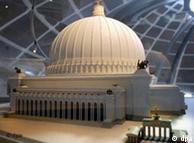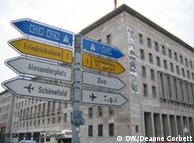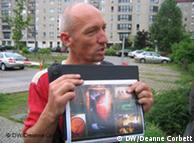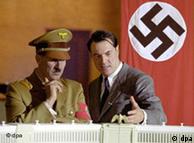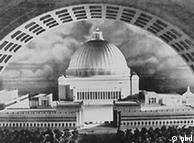Published by H-German@h-net.msu.edu (January, 2009)
Paul Ciupke, Franz-Josef Jelich, eds. _Weltanschauliche Erziehung in Ordensburgen des Nationalsozialismus: Zur Geschichte und Zukunft der Ordensburg Vogelsang_. Essen: Klartext Verlag, 2006. 190 pp. EUR 19.90 (paper), ISBN 978-3-89861-713-0.
Reviewed for H-German by Mark A. Bullock, Department of History, University of Illinois at Chicago
Vogelsang: A Castle Made of Sand
In 2006, _Ordensburg_ Vogelsang, in Germany's Eifel National Park, was opened to the public for the first time since the end of the Second World War. This opening sparked a debate among scholars, concerned citizens'associations, and local and regional government agencies about how this former training ground for a Nazi elite should be utilized and remembered.
This "castle," unbeknownst to many of its recent visitors, was part of an ambitious Nazi project, initiated by Robert Ley, to educate and train a corps of young Germans to lead the Third Reich into its thousand years of glory. The editors of this collection, Paul Ciupke and Franz-Josef Jelich, after introducing Vogelsang's past, ponder its future, asking if such places of "evil" should be ignored and allowed to fall into ruins. Or, should Vogelsang be retained as a special place for learning about and remembering Germany's past? As scholars, they only consider the second answer to their rhetorical question, arguing that Vogelsang provides new insights about how National Socialism sought to sustain itself.
The story of Vogelsang remained obscure because there was no general access to the area, which was used as a training ground for British and Belgian soldiers until 2005. Built to blend into the surrounding landscape overlooking a valley, Vogelsang is one of the largest remaining examples of National Socialist architecture. It also represents yet another case of an ideology-fueled Nazi project that fizzled out. Constructed after 1934 to train "_Ordensjunker_," Vogelsang was one of four planned _Ordensburgen_.
These institutions were a part of the rather inchoate state and party apparatus that sought to provide further ideological education to young Germans both during and after primary school. Vogelsang competed with the Labor Service, Hitler Youth, and various Reich- and district (_Gau_) schools for recruits and influence over education. From 1936 until the end of the war, Vogelsang was used to teach young Germans Nazi ideology; first to the _Ordensjunker_, and later as an Adolf Hitler School (a type of boarding school for boys aged twelve to eighteen frequently described as a "prep school" for the _Ordensburgen_, founded in 1937 by Ley in cooperation with Baldur von Schirach, head of the Hitler Youth). Unlike other Nazi sites of commemoration, no obvious atrocities were planned or committed at Vogelsang.
Instead, it was a place of socialization and instrument of domination, where the Nazi state engendered acceptance and support from young Germans. The history of Vogelsang tells us more about Nazi fantasies than anything else, for it never fulfilled its primary mission, having never graduated a single class of "cadets."
Although opening Vogelsang to the public entails some risk, it also presents an opportunity for discussing how the Third Reich sought to wed its ideology to pedagogic theory to indoctrinate a faithful corps of young adherents. The editors grapple with the problem of deciding which elements of Vogelsang's history are useful for furthering the understanding and discussion of the Nazi past. The contributors to this book approach Vogelsang from a variety of academic disciplines. Their essays span the disciplines of history, architecture, history of education, and cultural studies.
One complex of essays in the volume treats the theme of education, its content, and its audiences. Lutz Raphael's essay recapitulates the components of Nazi ideology, pointing out that Nazis targeted males under thirty more intensively than all other groups. But, of the some 500 young men who began the elite school in 1937, only 17 percent finished the first year. Vogelsang was similar to other types of Nazi schooling in that it emphasized military order, discipline, and hardness, as well as submission of individualism to the community. Kiran Klaus Patel discusses extracurricular National Socialist pedagogy in the so-called "camp" system.
Patel notes the generally low academic standards maintained in the "camp" schools, which focused on drilling ideology. Vogelsang, despite its designation as an "elite" school, had much in common with the low academic achievements of the camp system. Even worse, according to the author, Vogelsang included no practical training for running party and state organizations. Patel claims that this emphasis on ideology over praxis is typical of Ley's contribution to the Nazi educational system.
Vogelsang did little beyond conveying superficial propaganda, a fundamental problem that largely explains why the _Ordensburg_ failed to attract or retain a sufficient number of candidates. Gisela Miller-Kipp's contribution focuses on the concept of "elite" education in the Third Reich. Based on an analysis of the Adolf Hitler Schools (AHS) and oral histories of former students, she argues that elite schooling for the best male students is really a postwar concept and that the AHS did not, in fact, differ significantly from other, non-elite schools under the Nazis. While former students might remember themselves as part of an elite, historians should not describe this institution as successfully producing a corps of superior young Germans. Instead, Miller-Kipp contends that the AHS engendered an "elite consciousness" among its students by filling them with a sense of awe at the massive, monumental scale of Vogelsang. They came to see the greatness of the Third Reich and internalized a sense of power based on their close proximity to the state.
Physical education in AHS is the subject of Harald Scholtz's contribution, which discusses how Hitler's "inversion" of traditional, humanist educational theories was put into practice by his paladins. One such contrast was the predominant role of physical education. Entrance "exams" for the AHS focused primarily on the child's physical and mental hardness.
Upon entry, Hitler's "elite" students were subjected to a mostly improvised course of instruction, since school leaders failed to draft lessons plans for most subjects before 1944. AHS students, who graduated with the _Abitur_, did not attend regular classes for more than four years. Alfons Kenkmann's contribution clarifies the identity of the _Ordensjunker_.
Candidates to the _Ordensburgen_ were between twenty-three and thirty years of age, and those over twenty-six had to be married. In addition, they had to be party members, or at least demonstrate proof of participation in Nazi organizations, and be physically healthy and racially "pure." Successful candidates were admitted to a four-year course of study, each year at a different _Ordensburg_. The first class was admitted in 1937, but no cohort ever completed the full four years, as the war interrupted the program in 1939.
A second group of essays documents Vogelsang's institutional and architectural contexts. Gerhard Klein recounts the history of Vogelsang's sister _Ordensburg_, Sonthofen, in Bavaria. Constructed in 1934, Sonthofen, like Vogelsang, played a marginal role in training _Ordensjunker_. Klein notes that Sonthofen could claim a number of world-class athletes among its student recruits.
Sonthofen's alpine location afforded the athletes optimal training conditions, while the state provided financial support. But Sonthofen's most important function in the Third Reich was as an AHS after 1937. Monika Herzog's essay on the construction history of Vogelsang notes that, other than its monumental scale, no one feature defined Nazi architecture. Most buildings constructed during the Third Reich were admixtures of old and modern styles, for Hitler did not want to merely copy the great structures of the past, but believed that his Germany should create its own style.
Vogelsang's designer, Clemens Klotz, adhered to neither the old nor new schools, but he still effectively combined the two styles in his plans for the _Ordensburg_. Relying on wood and stone, Klotz designed a building complex that placed a new, National Socialist spin on an object representing Germany's crusading past--the castles of the Teutonic Knights, which were both temples of worship and staging areas for military conquest. Klotz intentionally incorporated these concepts in Vogelsang's design, creating a totalizing aesthetic concept to house and train a corps of young men to spread their quasi-religious racial beliefs as they expanded Germany's power.
A third group of essays addresses the structure's postwar history. In his first essay, Michael Schröders gives a brief history of Vogelsang after its capture by American troops in early 1945 and subsequent use as a barracks and training area for British and then Belgian soldiers. The Belgians took pains to preserve the historical substance. In addition to repairing structures damaged during bombing, the Belgians even restored some of the Nazi reliefs, despite their overt fascist symbolism. In a second essay, Schröders describes the fate of Vogelsang's significant library in the years following the war. In an effort to protect the collection, its head librarian dispersed it across several local schools. Presumably half of these items were never recovered, and records were poorly maintained after the war. The universities of Bonn and Cologne, whose libraries were damaged in the war, ended up with some 20,000 volumes. Aside from small holdings of Nazi literature, the bulk of which was in the form of party journals and magazines, Vogelsang's library was indistinguishable from any academic library containing standard collections on history, theology, law, political science, art, and literature.
The volume closes with several pieces on the current significance of the structure. Fortunately, Vogelsang will not suffer abandonment or destruction, as its unique surroundings led to the formation of the Eifel National Park in 2004. Moreover, several foundations and local, regional, and state governments have banded together to determine how to best transform Vogelsang into a documentation center, as well as a multi-use tourist destination. Efforts are already underway to create an on-site museum that places the castle's history within the context of the Nazi quest to build a racially pure nation. The elite schools stood alongside the Nazi euthanasia and forced sterilization programs in Hitler's plan for a "new" Germany. Yet Vogelsang's future also includes a museum for nature and environment, as well as an administrative and visitor center for the national park. Volker Dahm argues that allowing the site to fall into ruin, or barring public access, will establish a counterproductive "aura of secretiveness" about the location.
The program for the site's rehabilitation can only be understood in the context of similar activities elsewhere. In separate essays, Manfred Struck and Bernd Faulenbach describe how former Nazi sites are selected for preservation and how public access is controlled. They enumerate recent trends in how Nazi sites are preserved and utilized for future generations, pointing in particular to sites like Vogelsang, where none were tortured or murdered. While much consideration is given to the recently opened displays at Obersalzberg and Nuremberg, the articles by Struck and Faulenbach ignore other innovative efforts to preserve, or at least find new uses for, structures from the Nazi past. Mostly local groups have enthusiastically sought to preserve and document the massive flak towers and air-raid bunkers that still exist, most notably in Berlin-Gesundbrunnen and Hamburg. For example, Berliner Unterwelten, e.V. provides chilling tours of the bunker complex and flak tower in Humbolthain Park. Hamburg's flak tower now contains recording and radio studios. The omission of these imposing remnants of Nazism seems like a missed opportunity to widen the scope of these articles, for these flak towers and bunkers have been preserved and simultaneously found new uses, including as economically sustainable educational centers.
The final essay, by Rainer Stommer, considers the modern fate of another monumental project by Vogelsang's architect: Prora, formerly known as KdF-Seebad Rügen, which lies incomplete on the Baltic coast, encompassing an area nearly the size of the Nuremberg party rally site. Intended as a seaside resort, the project's massive scale prevented its completion before the outbreak of war. From 1952 until German reunification, the resort served as a barracks for East Germany's army. Stommer mainly details the German federal government's efforts to find new uses for this massive complex, much of which lies in ruins. A central block of the development now holds museums, both private and state-owned, but many buildings remain unoccupied.
Success in attempts to attract buyers to convert the functional structures into hotel, retail, and residential spaces has been mixed, as refurbishment costs are prohibitive. Stommer laments this troubling state of affairs and argues that purely economic considerations should not determine the fate of Prora. To allow it to fall apart would be to lose not only the chance to document and teach about the Third Reich, but also an opportunity to support an economically depressed region through sponsoring tourism.
Vogelsang is an exceptionally complex space due to its combination of landscape, architecture, and former political function. While not a place to memorialize the victims of a criminal regime, Vogelsang nonetheless reminds of the Nazi past. It was, as the volume's editors write, "a place of educational power, of selection, and indoctrination" (p. 11). This collection casts light on an interesting and little-understood component of the National Socialist education system. The largest criticism I have to offer lies in the organization of the volume; often vital information that would be helpful to understanding material at the beginning of the volume is not discussed until later essays; both Kenkmann's and Klein's essays cover material that really belonged in the editors' introduction. Although some articles lack enough context and frequently overlap in terms of material covered, they nonetheless offer an insightful and cross-discipline analysis of Vogelsang. They provide a glimpse into the deliberations behind the project of preserving and documenting historical structures bound to the Nazi past. But their primary contribution comes in the field of educational history. Several authors debunk the myth of "elite" schooling in the Third Reich through their close analyses of the _Ordensjunker_ program and the AHS housed in Vogelsang.







 One of Hitler's favorite daydreams was a new, rechristened Berlin -- Welthauptstadt Germania, the worthy and illustrious capital of the One Thousand Year Reich. Together with pet architects like Albert Speer, the Führer liked to unwind from a hard day of military disaster on the Russian Front by plotting the lovely Germania, where everything was monumental, marble-plated, and situated on a boulevard at least a mile wide. Speer's office had a whole room given over to a scale model of the city of the future, which Hitler could access from the Chancellery gardens and pore over in private.
One of Hitler's favorite daydreams was a new, rechristened Berlin -- Welthauptstadt Germania, the worthy and illustrious capital of the One Thousand Year Reich. Together with pet architects like Albert Speer, the Führer liked to unwind from a hard day of military disaster on the Russian Front by plotting the lovely Germania, where everything was monumental, marble-plated, and situated on a boulevard at least a mile wide. Speer's office had a whole room given over to a scale model of the city of the future, which Hitler could access from the Chancellery gardens and pore over in private..jpg)



